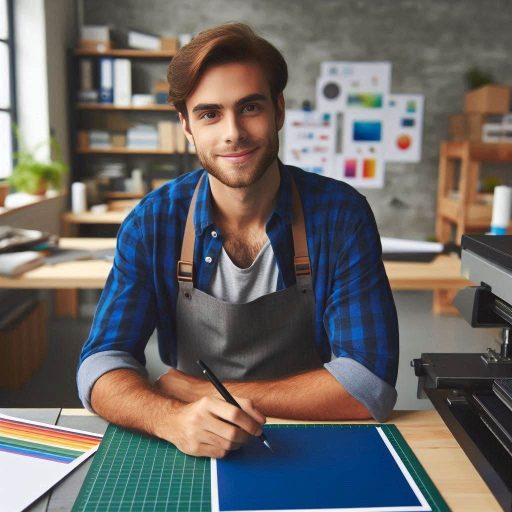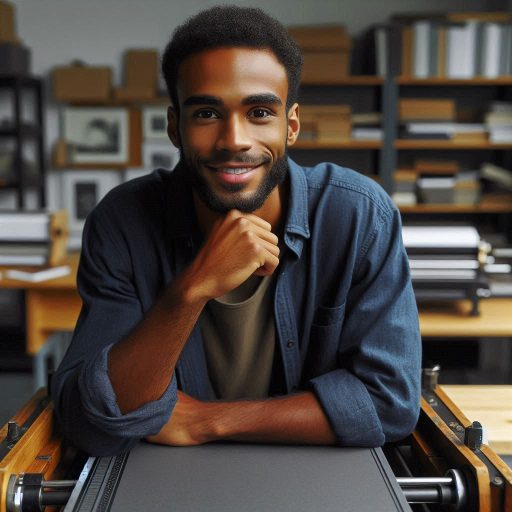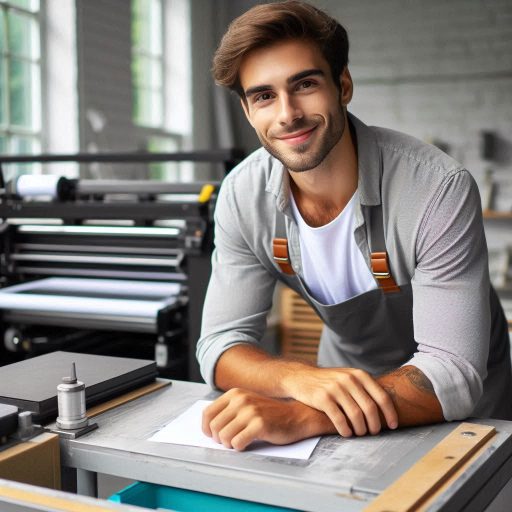Introduction
Printmaking is a versatile art form that involves creating artworks by transferring ink from a matrix or plate onto paper or another surface.
It allows artists to produce multiple copies of the same image, making their work accessible to a wider audience.
Explanation of printmaking as an art form
Printmaking encompasses various techniques such as relief, intaglio, lithography, and screen printing.
Each technique offers unique possibilities for artists to experiment and create visually captivating works.
Importance of exploring different printmaking techniques
By exploring different printmaking techniques, artists can expand their creative horizons and develop their artistic skills.
Each technique offers a distinct process and aesthetic, allowing artists to discover new ways of expressing their ideas and emotions.
Additionally, experimenting with various printmaking techniques can lead to unexpected and exciting outcomes, pushing artists out of their comfort zones and encouraging innovation in their work.
Whether working with traditional methods or incorporating digital processes, artists can benefit from the diversity and richness of printmaking techniques.
Furthermore, mastering multiple printmaking techniques can enhance an artist’s versatility and flexibility in their practice.
It allows them to adapt their approach and choose the most suitable technique for each project, resulting in more dynamic and impactful artworks.
Overall, exploring different printmaking techniques can be a rewarding experience that stimulates creativity, encourages artistic growth, and opens up new possibilities for artists to express themselves freely.
History of Printmaking
Printmaking has a long history dating back to ancient times.
The earliest form of printmaking can be traced back to China.
Overview of the origins of printmaking
The Chinese invented woodblock printing around the 9th century.
This technique involved carving images into a wooden block.
Ink would then be applied to the block and transferred onto paper.
Evolution of different techniques over time
Printmaking spread to Europe during the 14th century.
Engraving and etching were developed during the Renaissance.
These techniques allowed for more intricate and detailed prints.
Lithography was invented in the late 18th century.
Transform Your Career Today
Unlock a personalized career strategy that drives real results. Get tailored advice and a roadmap designed just for you.
Start NowThis method utilized a greasy crayon on a smooth surface.
The invention of photography in the 19th century revolutionized printmaking.
Artists could now transfer photographic images onto printing plates.
Relief Printing
Explanation of relief printing technique
In relief printing, the image to be printed is raised from the background surface.
This means the non-printing areas are carved away, leaving the image in relief.
Examples of relief printing methods
There are various methods of relief printing, including:
- Linocut: An artist carves a design into a piece of linoleum mounted on a block of wood or other material.
Ink is then applied to the surface, and paper is pressed onto it to transfer the image. - Woodcut: This technique involves carving a design into a block of wood.
The raised areas hold the ink, which is then transferred onto paper by applying pressure using a printing press or by hand.
Both linocut and woodcut techniques require a skilled hand to carefully carve the design and apply the right amount of ink for a successful print.
Read: Skills Needed to Excel in Printmaking
Intaglio Printing
Description of the intaglio printing process
Intaglio printing is a traditional printing technique that involves incising an image or design into a surface.
This process typically involves creating an image on a metal plate, such as copper or zinc, through various methods.
Once the image is etched or engraved into the plate, ink is applied to the surface and then wiped clean, leaving ink only in the incised lines.
Finally, a dampened piece of paper is pressed onto the plate, transferring the inked image onto the paper.
Different types of intaglio techniques
Etching
Etching is a popular intaglio technique where an acid-resistant coating is applied to the metal plate.
The artist then uses a tool, like a needle, to draw into the coating, exposing the metal underneath.
The plate is then submerged in an acid solution that eats away at the exposed metal, creating incised lines that will hold the ink.
Engraving
Engraving is another intaglio technique that involves directly incising lines into a metal plate with a sharp tool, known as a burin.
The artist uses the burin to carve into the plate, creating grooves and lines that will hold the ink when printed.
Engraving allows for precise and fine detailing in the final print.
Overall, intaglio printing is a versatile and intricate printing process that allows artists to create detailed and textured prints.
Through techniques like etching and engraving, artists can experiment with different line qualities and textures to achieve unique and visually captivating prints.
Transform Your Career Today
Unlock a personalized career strategy that drives real results. Get tailored advice and a roadmap designed just for you.
Start NowWhether creating intricate illustrations or abstract designs, intaglio printing offers endless creative possibilities for artists to explore.
Read: Printmaking Techniques: Collagraph Printing
Lithography
Lithography is a printmaking technique that uses a flat surface, typically a stone or metal plate, which is treated to repel ink except where the image is to be printed.
How Lithography Differs from Other Techniques
Lithography does not involve carving or incising into a surface like in intaglio or relief printing.
Unlike screen printing, lithography does not require forcing ink through a stencil.
It is distinct from digital printing as it is a hands-on process involving chemical reactions on the printing surface.
Steps Involved in Creating a Lithograph
- Preparing the Surface: The stone or plate is grained to create a smooth, even surface for drawing.
- Drawing with Grease Pencil: Using a greasy medium, the artist draws the image on the prepared surface.
- Chemical Treatment: The surface is treated with a mixture of gum arabic and acid to fix the image in place.
- Inking the Surface: Ink is applied to the surface, adhering only to the greasy areas where the image was drawn.
- Printing: The surface is pressed onto paper, transferring the inked image to create the final lithograph.
Overall, lithography offers artists a versatile and intricate method of creating prints without the need for carving or stencils.
The process involves a delicate balance of chemical treatments and artistic skill to produce stunning and detailed images on paper.
Screen Printing
In the world of printmaking, screen printing is a modern technique that has gained popularity due to its versatility and ability to create bold, vibrant designs.
Here, we will explore the basics of screen printing and its various applications in art and design.
Introduction to Screen Printing
Screen printing, also known as silk screening, is a method of printing in which ink is transferred onto a substrate through a mesh screen.
The screen is stenciled to block off areas where ink should not pass through, allowing for precise and detailed designs to be printed.
This technique is commonly used for creating posters, t-shirts, tote bags, and other merchandise.
Screen printing can be done manually or with automated machines, making it accessible to artists and designers of all levels.
Various Applications of Screen Printing
- Textile Design: Screen printing is widely used in the fashion industry to create unique patterns and designs on clothing and accessories.
The technique allows for vibrant colors and intricate details to be printed on fabric. - Art Prints: Many artists use screen printing to create limited edition art prints.
The layering process in screen printing produces rich, textured prints that are highly sought after by collectors. - Signage and Posters: Businesses and organizations often use screen printing for producing signage, posters, and banners.
The durability of screen printing makes it ideal for outdoor advertising. - Packaging Design: Screen printing is also employed in packaging design to add branding and visual interest to products.
The technique can be used on materials such as paper, cardboard, and plastic. - Ceramics and Glass: In addition to textiles and paper, screen printing can be applied to ceramics and glassware.
Artists and designers can create custom dishes, mugs, and decorative items using this technique.
Overall, screen printing offers endless possibilities for creative expression and is a valuable tool for artists, designers, and businesses looking to make a statement with their printed materials.
Read: Tips for Maintaining Your Ceramic Art Studio

Monotype Printing
What is Monotype Printing?
Monotype printing is a unique printmaking technique that involves creating a one-of-a-kind image on a smooth, non-absorbent surface, such as glass or metal plate.
The image is then transferred onto paper using pressure, resulting in a singular print.
How Monotype Printing Works
To create a monotype print, the artist first applies ink or paint to the smooth surface, manipulating it to form the desired image.
The surface is then placed on a press, along with a piece of paper, and pressure is applied to transfer the image onto the paper.
Transform Your Career Today
Unlock a personalized career strategy that drives real results. Get tailored advice and a roadmap designed just for you.
Start NowUnique Characteristics of Monotype Prints
Monotype prints are known for their spontaneity and unpredictability, as each print is a one-off image that cannot be replicated exactly.
The process allows for experimentation and creativity, making each print truly unique.
Advantages of Monotype Printing
One of the key advantages of monotype printing is its versatility.
Artists can use a variety of inks, paints, and tools to create different effects and textures, resulting in a wide range of artistic possibilities.
Applications of Monotype Printing
Monotype printing is popular among artists for creating original, expressive artwork.
It can be used to produce both abstract and representational prints, allowing artists to explore different styles and techniques.
Monotype printing is a dynamic and versatile printmaking technique that offers artists the opportunity to create unique, one-of-a-kind prints.
Its spontaneity and creative potential make it a popular choice among artists looking to explore different printmaking techniques.
Experimental Printmaking Techniques
When it comes to printmaking, artists have continuously explored unconventional methods to push the boundaries of traditional techniques.
These experimental techniques often result in unique and innovative artworks that challenge the norms of the art world.
Unconventional Printmaking Methods
Experimental printmaking techniques defy traditional norms by introducing innovative methods and materials.
These unconventional approaches offer artists a way to break free from standard practices and explore new possibilities in their work.
One such method involves incorporating non-traditional materials into the printmaking process.
For instance, artists may choose to print on surfaces like fabric, metal, or wood instead of the usual paper.
This choice allows them to create unique textures and effects that standard paper cannot replicate.
Another notable experimental technique is monotype printing.
Unlike traditional printmaking methods that produce multiple prints from the same plate, monotypes result in a single, unique print.
Artists apply ink or paint directly onto a plate, then transfer it to paper.
This technique yields one-of-a-kind results, making each print distinct.
Monotype printing is celebrated for its spontaneity and the opportunity it provides for artists to experiment with color and form.
Transform Your Career Today
Unlock a personalized career strategy that drives real results. Get tailored advice and a roadmap designed just for you.
Start NowCollagraphy, another experimental method, involves creating prints from a collaged plate.
Artists build up textures on a plate using various materials such as fabric, sand, or textured paper.
After inking the plate, they transfer the design to paper, resulting in rich, tactile prints.
Collagraphy allows artists to incorporate diverse textures and visual elements into their work, pushing the boundaries of traditional printmaking techniques.
Examples of Artists Who Push the Boundaries of Traditional Techniques
Several artists are renowned for pushing the limits of traditional printmaking through experimental techniques.
Robert Rauschenberg, for instance, is celebrated for his use of non-traditional materials in printmaking.
His works often feature found objects and unconventional surfaces, resulting in mixed-media prints that challenge conventional aesthetics.
Edgar Degas is another prominent figure known for his use of monotype printing.
Degas‘s approach to this technique produced unique and expressive prints that set him apart from his contemporaries.
His innovative use of monotypes contributed to the development of printmaking as an art form.
Glen Alps is notable for his contributions to collagraphy.
His work exemplifies how artists can use collaged materials to create richly textured prints.
Alps‘s exploration of this technique has influenced many printmakers, showcasing the creative potential of collagraphy.
Cory Arcangel represents a modern take on experimental printmaking.
By integrating digital tools such as computer-generated imagery and laser cutting,
Arcangel creates prints that merge traditional techniques with contemporary technology.
His work exemplifies how digital advancements can enhance and transform the printmaking process.
In summary, experimental printmaking techniques offer artists new ways to express themselves and push artistic boundaries.
By incorporating unconventional materials, exploring methods like monotype printing and collagraphy, and embracing digital tools, artists continually expand the possibilities of printmaking.
Learn More: How to Create Timeless Fashion Designs
Transform Your Career Today
Unlock a personalized career strategy that drives real results. Get tailored advice and a roadmap designed just for you.
Start NowBenefits of Exploring Different Printmaking Techniques
There are numerous advantages to experimenting with various printmaking techniques, from traditional to contemporary methods.
By exploring different techniques, artists can unlock new possibilities and push the boundaries of their artistic skills.
Expand Your Creative Horizons
Trying out different printmaking techniques can help you break out of your comfort zone and explore new ways of creating art.
It allows you to discover unique approaches that you may not have considered before.
Enhance Your Problem-Solving Skills
Each printmaking technique comes with its own set of challenges and limitations.
By testing out various methods, you can develop your problem-solving skills and adapt to different situations while working on your art.
Develop a Unique Style
Exploring different printmaking techniques allows you to blend various styles and methods, ultimately helping you to develop a distinct and recognizable artistic style.
It can set you apart from other artists and make your work more memorable.
Improve Your Technical Skills
Working with different printmaking techniques exposes you to a range of technical skills, such as carving, etching, and embossing.
By mastering these techniques, you can improve your overall artistic abilities and craftsmanship.
Experiment with Texture and Depth
Each printmaking technique offers a unique way to create texture and depth in your artwork.
Whether it’s through relief printing or intaglio, exploring different techniques can add richness and complexity to your pieces.
Spark Your Creativity
Trying out new printmaking techniques can ignite your creative spark and inspire new ideas for your artwork.
It opens up a world of possibilities and encourages you to think outside the box when it comes to your creative process.
Build Confidence in Your Abilities
As you experiment with different printmaking techniques and see improvement in your skills, you’ll gain confidence in your abilities as an artist.
This sense of accomplishment can motivate you to continue challenging yourself and growing as a creative individual.
Connect with a Community of Artists
Exploring different printmaking techniques can introduce you to a community of artists who share your passion for creating art.
By connecting with others who are also experimenting with various methods, you can learn from each other, exchange ideas, and expand your creative network.
Overall, exploring different printmaking techniques offers a wealth of benefits for artists of all levels.
Whether you’re a beginner looking to improve your skills or an experienced artist seeking to push the boundaries of your creativity, trying out new techniques can open doors to new artistic possibilities and help you grow as an artist.
Transform Your Career Today
Unlock a personalized career strategy that drives real results. Get tailored advice and a roadmap designed just for you.
Start NowConclusion
Exploring different printmaking techniques is essential for artists looking to expand their creative repertoire and improve their skills.
By experimenting with various methods such as relief, intaglio, lithography, and screen printing, artists can discover new ways to express their ideas.
It’s important to remember that each technique offers unique opportunities for artistic expression and can lead to unexpected and exciting results.
Artists should not be afraid to try out new methods and push their boundaries to see what they can create.
Expanding one’s artistic horizons through exploration of different printmaking techniques can lead to growth and innovation in one’s work.
So, I encourage all readers to step outside of their comfort zones and experiment with a variety of printmaking techniques to enhance their artistry.
Remember, the possibilities are endless when it comes to printmaking, and the only way to truly grow as an artist is to explore and try new things.




